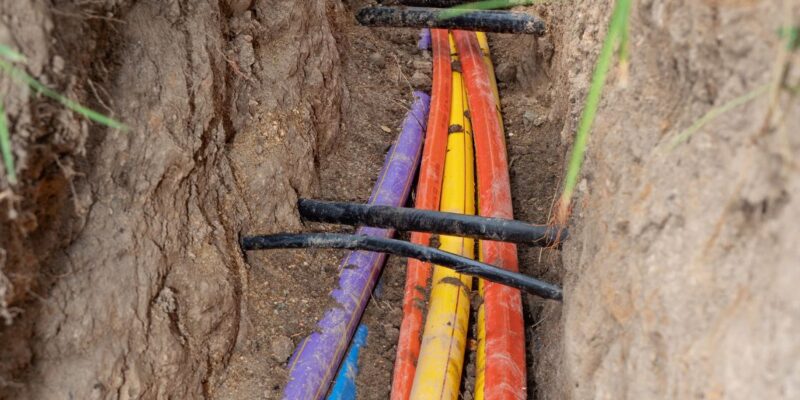Beneath our feet lies a vast network of vital infrastructure, including pipelines, cables, and other utilities. These underground networks are often overlooked until something goes wrong. This is where underground infrastructure detection plays a pivotal role, with techniques like Ground Penetrating Radar (GPR) becoming increasingly more important. Yet, simply possessing GPR equipment isn’t enough; proper training is needed to effectively navigate the subterranean maze of utilities. In this blog, we’ll explore the value of training in underground infrastructure detection, demonstrating how it ensures accuracy, safety, and efficiency.
Why GPR is Helpful for Underground Utilities Detection
Before we explore why proper training is vital for underground utilities detection, let’s briefly showcase why GPR is a useful tool for such an application:
Non-Destructive
GPR is non-destructive, meaning it does not require excavation or disruption of the ground to detect underground utilities. Instead, it emits electromagnetic pulses into the ground and analyzes the reflections to identify subsurface objects. This non-invasive approach minimizes disruption to the surrounding environment and reduces the risk of damage to existing infrastructure.
Versatility
GPR can be used to detect a wide range of underground utilities, including pipelines, cables, conduits, and storage tanks, among others. It is suitable for various soil types and can penetrate different materials, such as soil, concrete, asphalt, and even ice. This versatility makes GPR a valuable tool for a diverse range of applications, from construction and infrastructure development to environmental monitoring and archaeological research.
Accuracy
GPR provides high-resolution imaging of the subsurface, allowing technicians to accurately locate underground utilities with precision. Its ability to distinguish between different materials and detect anomalies enables technicians to identify the precise location, depth, and orientation of underground objects. This level of accuracy helps minimize the risk of misidentification and ensures reliable results.
Efficiency
GPR allows for rapid data collection and real-time analysis, enabling technicians to quickly assess underground conditions and make informed decisions. Its portability and ease of use make it well-suited for field applications, facilitating efficient data collection in various environments and conditions. This efficiency translates into time and cost savings for projects involving underground utilities detection.
The Complexity of Underground Utilities Location
Underground utilities location via GPR is complicated. The subsurface environment is complex, with various utilities often positioned in close proximity, sometimes even stacked vertically. This intricate network is challenging for accurate detection, as overlapping signals and interference can complicate the process. Furthermore, the composition of the ground itself can affect detection, with different soil types affecting GPR signals.
Here, the role of training becomes clear. Properly trained technicians have the knowledge and expertise to interpret GPR data accurately. They understand the principles of electromagnetic wave propagation in different soil conditions and can distinguish between signals originating from different types of utilities. Training also equips technicians with the skills to overcome common challenges, such as signal attenuation and reflections, ensuring more reliable results.
The Benefits of Training in Underground Utilities Detection
Proper training in underground utilities location offers many benefits, including:
Accuracy
Accuracy is crucial in underground infrastructure detection, as it directly impacts the safety, efficiency, and cost-effectiveness of excavation projects. Proper training plays a pivotal role in ensuring technicians can interpret data accurately, distinguishing between different types of underground utilities and minimizing the risk of misidentification or false positives.
One of the primary downsides of inaccurate detection is the potential for damage to existing infrastructure during excavation projects. Mistaking a gas pipeline for a water pipe or an electrical cable can have catastrophic consequences, including gas leaks, electrical outages, or even explosions. By accurately identifying underground utilities, trained technicians can effectively plan excavation activities, avoiding conflicts and ensuring the integrity of existing infrastructure.
Safety
Accurate detection contributes to safety by reducing the risk of accidents and injuries. Trained technicians understand the potential hazards associated with underground utilities and follow safety protocols to minimize risks to personnel and the surrounding community. For example, they may implement safety measures such as marking utility locations clearly and establishing exclusion zones to prevent accidental strikes during excavation.
Efficiency
Efficiency is another key benefit of accurate underground infrastructure detection. Trained technicians have the skills to navigate the complexities of detection efficiently, identifying optimal methods and interpreting data effectively. By streamlining the detection process, they minimize delays in construction projects and ensure timely completion. Additionally, efficient detection practices help organizations optimize resource utilization, maximizing productivity and reducing costs.
Cost-Effectiveness
Accurate detection contributes to cost-effectiveness by reducing the likelihood of costly errors and rework. Damage to underground utilities can result in significant expenses, including repair costs, litigation, and project delays. By investing in training, organizations can avoid these unnecessary expenses and save both time and money. Trained technicians are equipped to identify potential risks and implement preventive measures, reducing the likelihood of costly incidents during excavation projects.
Compliance
Proper training ensures compliance with regulations and standards governing the detection and management of underground utilities. Many jurisdictions have specific requirements in place to protect underground infrastructure and minimize risks to public safety. By familiarizing technicians with these regulations and industry best practices, training helps organizations meet their legal obligations and avoid potential legal consequences associated with non-compliance.
The Vital Role of Training in Underground Infrastructure Detection
When it comes to underground infrastructure detection, proper training is a necessity. It ensures accuracy, safety, and efficiency, allowing technicians to handle the complexities of the subterranean landscape with confidence and competence. Whether using Ground Penetrating Radar (GPR) or other detection methods, trained professionals play a crucial role in safeguarding underground utilities and mitigating risks associated with excavation activities.
The importance of training in underground infrastructure detection cannot be overstated. By investing in training and professional development, technicians are empowered to uphold the highest standards of quality and safety, ensuring the integrity and reliability of our underground networks for generations to come.

